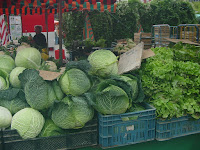Grow Food for Money on Borrowed Land
 Curtis Stone is excited about encouraging more and
more people to take up urban farming (http://theurbanfarmer.co). So excited, in
fact, that he has books, podcasts and websites full of free information to help
anyone get started growing food for profit.
Curtis Stone is excited about encouraging more and
more people to take up urban farming (http://theurbanfarmer.co). So excited, in
fact, that he has books, podcasts and websites full of free information to help
anyone get started growing food for profit.
His book, “The Urban Farmer: Growing food for profit
on leased and borrowed land”, provides over 250-pages of tips, formulas, bed
layout plans, plant lists and step-by step instructions.
The key message is, “The important thing is to just get started. Because
once you show people you are willing to do the work all kinds of opportunities
will present themselves. Once you move past the talk, and you put your
words into action, people see those actions, and opportunities just present
themselves.”
Stone farms on urban
plots. He borrows or leases neighborhood front yards and vacant lots that total
one-third acre or 15,000 square feet. From that one-third acre, he sells
$80,000 in vegetables annually.
The Pareto Law (80/20
rule) is the focus of his podcast on the Permaculture Voices website (www.permaculturevoices.com).
That means: focus on the 20% of customers and products that bring the highest
profits.
Ten rules came from a review of his spreadsheets:
Follow your own ideology but be reasonable, be an early adopter, start small to
keep overhead low, seek out experienced farmers for high quality information, focus
on things you can measure, measure everything, focus on high yield crops and market
streams, organize crop zones, diversify products and develop systems that can
be duplicated.
Stone double dug every bed on every plot every year
when he started. Now he uses a rototiller and no-till farming (weed-cloth) for
established beds.
He emphasizes that now is the time because farmers
are scarce. Less than 2% of North Americans know how to grow food, plus, the
average age of farmers today is 65 and they are retiring.
Gain the skills to be a farmer and you will always
have work. There has never been a better time to be a farmer than today and you
do not have to own land.
Vegetable production in neighborhoods builds social
equity. Put your growing plots in neighborhood front yards where they will be
seen and people will come to you for fresh food.
 Starting small is the key to urban farming. Stone
started with $7,000, some YouTube videos, a few library books and some borrowed
plots of land.
Starting small is the key to urban farming. Stone
started with $7,000, some YouTube videos, a few library books and some borrowed
plots of land.
Critical to success is high-grade information gained
from local growers. They can tell you which irrigation methods, soil
amendments, insect control works etc..
Stone recommends that new growers form groups
comprised of 1/3 who are where you want to be, 1/3 people who are where you
are, and 1/3 who are a bit behind where
you are. Sharing information with that group on a regular basis will accelerate
your learning exponentially.
Focus on harvesting, planting and marketing because
you can measure those. Weeding, thinning and irrigation are not things you can
measure. Give up on perfection; 85% is good enough.
Streamline processes with washing tables,
consolidated preparation area, drying tables and other simple solutions.
Stone uses an intensive farming method called SPIN
that optimizes harvest times. Half his beds are planted four times a season.
Stone’s rules for crop selection are clear. Only
grow crops with less than 85 days to maturity, with high yield per square foot,
good price per pound, that have a 4-month harvest period, vegetables that are in
high demand, and can be sold to area stores and chefs.
His business, Green City Acres, is in Vancouver, where
the growing season is 7 months. “Urban Farmer” is published by New Society, www.newsociety.com,
2016. $20. It is a must-read for
aspiring growers.





Comments